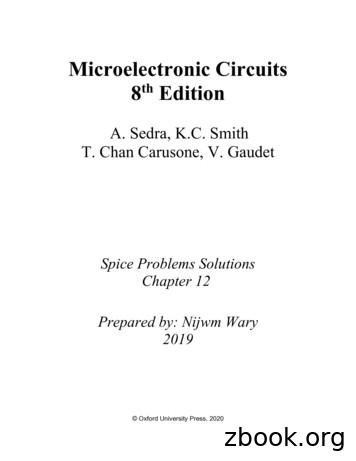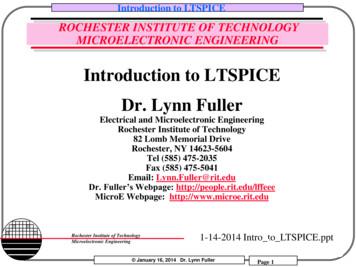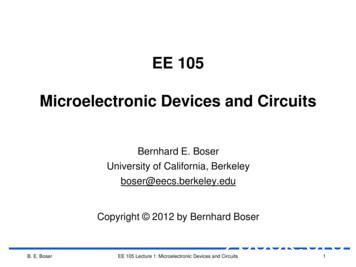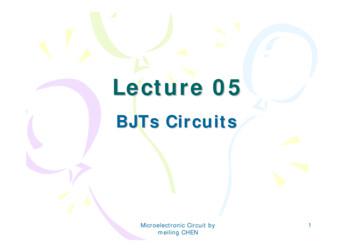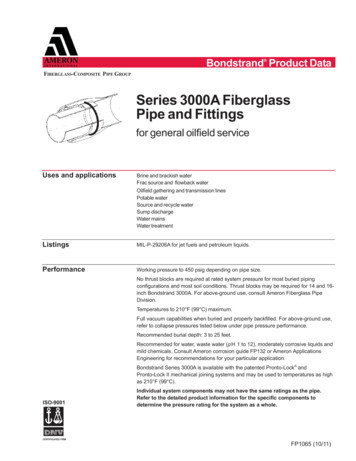Microelectronic Circuits International 6th Edition Sadra .
Exercise 1--2Ex: 1.5 f T""' 1000 Hz10 -JfI(b) T ., I1000 .flfC:'lj s '" l p. !0"J11.1 - I V D 00011 .12 V D "" 001015V D IIII(b) (i) I V (ii) 2 V (iii} 4 V (iv) 8 V(e) The closest discrete value rep.rcsented byDis 5 V; thus D " OIOL TI1c error is -0.2 V or-0.21 5.2 X 100 · · -·4%IF.x: 1.6 (al T(c) T """"I :x: 1.7 If 6 MHz is allocated for ench channel.then 470 MHz to 806 MHz will accmnodate806 - 470 '' 56 chnnnels6Since it starts with channel 14. it will go from :hannel 14 to ehanncl69Ex: 1.10 Voltage gain '" 20 log 100 · · 40 dBCurrent gain " 20 log 1000 "" 00 dBPower gain " 10 log A,. "' 10 log lA, A,)- 10 log )()5"' 50 dBP,,Ex: 1.1115 X 8120 mW120 . 18102 mW·r- -I ,. .!. --dtEx: 1.8 I'r.120R"'.!.x. xTT:czRv.,"' lPI P, P, .'"( r c: 7J (5· r k .y : xRx ' : ( 1 r:.Jl iJI 25l't.10II)'·' V "' IOp. V101' 10 --X T! i8; thus P becomes V 1 ! R as 8/ 1r 2.l)- 091. IXl""Ji(l .!9 ""'·)25 4 )'·') 17100.25 110RI106. 25 mW0.25 vI v !l\0.95P,6.25 mW and P;0.5 V and"'lllUS, ). rwhere P,s (,i-1···12 dBi, .ij ;;5 )Ii:J(jpIFra.:tion of energy in first nitw han non ics 1:::-Fmetiun of ent rgy in first seven harmonks0.96Noh: that JI) :;. of the energv of the square waw isin the lin t three harmonic;: that h. in the funda-mental and the third h;mnnnk.1',;md.AI'IVI l'vH! I M!l0.5 0.56.25 X 100.25 X 10 ''Ex: 1.9 (a) lJ ean rept\ ent 15 distinct valueshetween 0 anJ 15 V. Thus.l'.t 0 V D0000W-.-!!J X A X R1'"Rl i· I(.I - x I xHL . 0 . :25 VpPower nain ( 4 ) L. 9l" 25f11N;Voltage gainO.SI10I XFra .;tion of energy in tirst live harmonics····- (!;/J()I.With the butTer amplifier:l. . )found from dirCl'! calculation.Frat·tion of energy in fundamental ,. ( 10 X 10 . )IR049It can he shown by direct calculali 'll that the, hI?cc·infinite series in the parentheses h;ts a sum thatapproaches100 · 15%Ex: 1.12Altt mtively,pXlO log A,·.c44 dB0.5 p.A0.25 p.W0.25 V/V
Exercise 1-3This figure belong,.Ho. ExerCise Ll5r---1 "- tI()()K-lOt ,Ex: U3 Open-circuit (no load) output voltage At'n''iOutput·voltnge with load connectedRt"'· .A II; - . - -p"'L11 RL100'"'v,001!;2-lf,fl,11.Jl,v,vi2vilVsE ""· . !.: X ,!,! X .!.!""' 90.9 X 9. 9 X 0.909""8l8V/V uh "'' 818 I's ., 818 X I1-·- » R0R0 I"' -Ex: 1.14 A,.,.t·- For t', . ., I mV" R1 R"OJ - :- lM lOOK0.25 k.O818 mV250fl40 dB ""' 100 V/V"0.909 X 90.9 X 9.9 X 0.909::: 744""('A '" t'·-.!!.!: )rR'RI. Ro .2fur V,"' I mVI.2 v 'X(1oo x -I 1 -)I IIJOO' .IV.·n2.:hl,.744 xI mV744 mVt :x: J.17 Usiilg voltage amplifier model.it can berepresented asR,IOlogA,,Ex: 1.15 Without stage 3 (sec figure above) "' (IM) IO)( 100100KK Iu5100 K l- I M. X(100)( Ji}Q )IOO IK KR; "" I MH)R,. IOUA'", A,. 1 X A,.2 1),9 X 90.9· RL8 V , - R, RsVsVoVsEx: 1.16 Given v,For R 1 · 10 HOventll voltage gain(0.909)(10)(0.9901 )( 100)(0.() )09)I mVv,X AX'"'!! LRL R,· . !.!v.L X 900 X J Olf,0900 V!VThe overall voltage gainI M 1 100 K 0.909 So0.909 lis 0.909 X I ·"'· 0.909 mV10 ·' I()409 V/VFor R, '' 1000 HOverall voltage gain. 1'- i X 900 X -! .I M ! 100 KIOOO R10 VIV1000 10.·. Range of voltage gain is from 409 to Ill 0 VIVFor u, ,. , 1 mV1';29Xll ·""· t) )(19 mV
Exercise ··0·--··----·-···-t'J,G ihr" (13 I )ivR, i 6 {r., ( But vi 11,l)R,Iand ip i., thusEx:t.l9R,K": 1.22fGain10HzlOkHzlOOkHzI MHz60dB40dB20dBOdBGain !dB)RtR1 R,,,, "'t's-tis ""G,.t,1(R 0::O.,vsRlIIRE): Rs (Ro !1RL)111Ull.to t R,-tlo O,.--.-(R0R1 RstisIIR1)Ex: 1.20 Using transresistance circuit model thecircuit will bet04103.3 dBfrequencyEx.: 1.23 !1 is-·!Lv)1 -';.x R'"'G,.V 1.L ! .vCR, -1· RsRI. · · R0RoRr.Thus, Vo ""v,.i!L"'Rr R0Vo .""' Ri1Now V 0 Vo X !J. ' R .!!.L X .i!.Lisi 1 is"'Rt. Ra R1 Rs R -.!!.L X .!!.L."'Rs R1Rt R0I.G,.- -- - -R0RLIsC1 .::.L jRowhich is of the STC LP type.DC gain ' ?.!.Lt.LRnRl.100RL
Exercise 1--5.L RrJ 0,.R.1000"" 1Q.IOO - 0.1 ntA/VI ·· . 0.0& mA/VRI. .,:;·o·.I .O·.tR1. ·'o.! s kft .Ex: 1.24 Refer to Fig. El.23V2V sRI.R., .1. RsC'R,Rs - R, sswhich is a HP S'I'C function.12.skn1hdn ··. 2rrC(Rsc Rl) 5·- II· - -R,}C(Rs100Hz2rr(l 9) Hl X 100 '"' 0.16 ILF
Exercise 1--6Ex: 1.25b. 1imc tnken to cross 2 J.l.ffiT 50Kni ""'· BT;ne ···1Jgl(2K11length ' ::.1. ;6.75 X Hf""' 7.3 X IOJ\50)JI1. 9.6xe-1.12112xU2/IIJ-5x I!J' qnJt,.E L6 X 10" 19T"'"' 350Kn; ""· BTm e."" 7.3c. In n- i driff current density Jn inJ IO-:l9/cm3X JO' (JSQ)J/1 C·-l.la/tl X .42··- X I() X .1 01l V2x""' Aqn11n 0.25 X 10·-B X 1.08 X 104"" 27 11ANote 0.25 11-m 2From Exercise 3.1 n1 atT ,.,. 350 K 4.15X 0.25 x 10· 8 cm2dn(x)Sx. 1.29/,. ··· qD,--1011 /cnldxNv """ 10 11/cm 3From Figure E 1 2 9 10 17/cm "" 10 I (JJ.m) 3lluni2p,a!-N'Dn " 35 -1n·/sf)X 10 11 ) 21011dx-J106- -lit ·-qD dn(x),nPp N"Want electron concentrationwI.5 X lO 'I\dn 105 -0····· 10'1Lm 2Ex: 1.27At 300 K, n1 1.5 X IOH1/cm 3TIP ""4 235 x (10)(f.tmr /s: 35 X 10 (!1-m) 2 /s"' 1.72 x 106 /cnl1.6 X 10 19 X 35 X 108 X 105"" 56X10- 6AI( 11-m )2 56 11 A/( 11-m) 2"' 1.5 X 104 /cm)For 1. I mA ""1. X A - .4.2;. N A Pp !!!. I nv\ -· . !OJ IJ:A::::.18Jn56 )J.AI(t.l.tn) 2TIPEx;l.30( 1.5 X 10 10{1.5 X 104Using equation 1 . 4 51.5 X 1016fcmJD.llo v,.li-pDn Jl,V,. 1350X25.9XEx:l.28a. u,·driff - J.-nEHere negative sign indicates that electronsmove in a direction oppOSite toEWe use'-'··drifT !;DpX35 cm /s' )LpVT "'a.:12.4 cm2/sJ ;x: 1. 31-- ---,Equation 3 . 502 x Hr·4 . 4"" 6.75 X 10 cm/s "'""' 6.75 x 10 mlsW w- 2'" -!J.-.E·"-' 1350w-·l,, 1.08 XA!cm2d. Ddff current 1, Aqnu,.-dritrN 0 10 17/cm 3(4.l51350 X104Ex: 1.26 X 1{) 1t, Xlit/l!IITI 4.15 X 10 11 /cmlIt, ""'30 ps480 X 25.9 X 10-;!lltn
Exercise 1--7As one can sec from above equation, to increaseminority carrier-concentration (fin) by a factor of2. olic mu1 tlowcr ND ( n,) by a factor of2.J :x: l. 34Equntion391, LAqn 2( . .!!.e.1 L ,N1 0'"' D, )l N,,D.,D,since ··"' and ·-·· here approximatelyEx: 1.32t.,,L,In a p n diode N 1 NDAqu:(. 1. !!,/!. Jl!c . ),N vEquationl. 5U(,L,N, 1., lO"' X 1.6 X I()'x[vw -'---' --Equation 1. 52 X J'X519 : : (,L5 X 10 1) 1lJO .l! l16--4.·IS10 X 10 X 1010 -·1 X 1 N , N 0since N 1 NpNnI:::W· ;;;'I,( e\'/\' .1 ·-I)lY ,l,., .r:quatJon1 . .;- 3(. 1 )-.tl f(1.45 X 10 N ·. N 0· ),\, ' N,.10.2 mAN.N 0W- A'! . .---· \V since N. N1).;V,,Ex:l. 36::. A,1,v"w/l1.() XX J1().1.6 X 10- IQ1.66 : 1011( ! -- 1 ,)(0.814- 0.605)ern!(}IX10 1"0.166 IJ.rllr;:. - -- -A .j2 sqN 0 V 0Kx: 1. 37[ " " v In.- ampkN . 1. 2; 'f.:10' /em· andV11 ,." " ' " ------, - """t '( ; ; )v,. vi?JEx: 1.33to''inn·'In the ll·Tt';!ion nf thi' pn jm:tinn dioden,,J' . ,,\1 ,II,11,.IO"'tnn'll-? -::ll)'')'10"'(,J)l{u ingQ1) !()Clllequation 1- 53' ·V V ,Aq( - -"'-'·- ) Wiv , 1 /v "·0.601\Jllll
Exercise 1--8"·' I0- 4 xL6XIQ-ItJ ( IO18 . 16)XIOX6,(}8XI0-Scm1018 1016Ex: 1.40r::quation 1 . 7 4L2::J!. "' 9.63 pCD,.I "" Is "" llqn/(.!!.JL. [) )l.,.N[) L.N.,Reverse Current10···!4 X 1.6 X 10-l? X ( 1.5 X 10111 ) 2x( 5X10 · 10-4 X 10 16 18)10 X 10- X J0 1K7.3 X }(}" 15 A(5 X 10- 4/5--: 25 nsEquation 1 . 81cd (;:) 1In example 1.30 N,. "'" l0 18/crn1 N0""l0 16/cm 3A' suming NA Np' 'r::-.fl ""25 ns:.CJ "" ( 25 X 10- ). O.J X 10-J25.9 X 10 ( 101810 16)(X%.5pF! 10!6 0.8141018 3.2 pFBqualion 1 71Ci""C;oR3.2X10- 12 1.12pFEx: 1. 39C1 '1Sl.""dV-!!.{-.r/)dVd -{-.rXls(edvd Trl (e dV.VNT-J)]I'll'r- I))
Exercise 2--1Ex: 2.1Therefore:The rrrinimum number of terrrrinals required by asingle op amp is five: two input terminals, one outputterrrrinal, one terminal for positive power supply andone terminal for negative power supply.The minimum number of terminals required by aquad op amp is 14: each op amp requires twoinput terminals and one output terminal (accounting for 12 terminals for the four op amps). Inaddition, the four op amp can all share one terminal for positive power supply and one terminal fornegative power supply.Ex: 2.2v2 -V 1)isA J.LGmR. For G"' 10 mAN and100 we have:J.L104 YN Or equiva-100 X 10 X 10Alently 80dBEx: 2.4The gain and input resistance of the invertingamplifier circuit shown in Figure 2.5 are- R2 andR 1 respectively. Therefore, we have:Equation are v3 A(v2V;dV 3 J.LGmR(V 2That is the open-loop gain of the op ampv 1,-V;cm-R v 1 );R 1 100 kfl and12(v 1 v2 ) a) 0 - .1 -0.02 Y -2 mY103R 2 -10:: R 2RJThus:R 2 10 X 100 kflIOR 1IMfl 0.002 y0- ( -0.002)Ex: 2.52mYR IOkfl-1 mY!(-2mY O)23b) -10 lO (5- v 1) v 1 5.01 YV;d v2 5- 5.01 0.01 Y 10 mY11 1- (5.01 5) 5.005 y.::5Y1.1From Tablec)11311;d A(11 2 -11 1 ) v2 103 (0.998-1.002) -4Y ( 1.002 0.998) IYIV0R,d)-3.6 103 [712- (-3.6)] V;dJ2 v2- I-(v 12R; -3.6036- (-3.6)-0.0036 Y IO\v2 3.6)-3.6036 yV1 Vo) -3.6 mYEx: 2.3From Figure E2.3 we have: V 3 f.L V" and-G"'V 1)R G,R(V 2-V 1)0V; - Ri;0- Ri; - Ri;Ri; -R R,i; '0 ;" o-R-IOkflv!V;thus R.I I2[3.6 (-3.6)]-3.6 yVd (G"'V 2 0 I; 0 , i.e., output is open circuitThe negative input terminal of the op amp, i.e.,V; is a virtual ground, thus V; 0v 1 0.998 - 1.002 -4 mY-R,we have:and V; is a virtual ground (V; 0),Q 0 R.I 0 flI;Since we are assuming that the op amp in thistransresistance amplifier is ideal. the op amp haszero output resistance and therefore the outputresistance of this trans resistance amplifier is alsozero. That is R0 0n.
Exercise 2-2R Jb1cll v.Rt0:5 rnAC.onnectlng.the sig IUI source shown in Figure.e :s to the inp!ll (If this. amplifier we have:V; js a virtual .gruund that js V1 o. thi, s the r"tent flowing through the to kll resistt)l' connected ·between V1 and ground is i.ero. Thercfui'eV0V,-Rx0.5mA,O-IOK'X05mA"" -svFor.the cifuuit shown above we have:v J ""'(R"Rt v. RFR2 vl)Smceidsrequiredthat V 0We want to have:""-(V 1 5V 2 ).Rf· "" I and RF "" 5R1Ex: 2.6.R2 It is tllso desired that for a maximum output voltage oflO V the current in the feedback resistordoes notexceed l mA.n!CreforeJO V s I rnA R IO V * R f1R.r?!:10 killmALet us choose Rf to be 10 k!l. thenR 1 R1 JOkflandR1V 1 is a virtual ground,. thus V 1 0 V.'1 IV-V 1R11-0I k!l,. - - "" 52kflEx: 2.8I mAAssuming an ideal op amp. the current flowinginto the negative input temtinal of the op amp isz.ero. Therefore, i 2 i 1 i2 I mA -V 11 V 1 -· iL--10 · V 0i 2R 2 v.0 -·I mAX 10 kUv""Rt :: JO V - 10 lllt\I kUi 0 i1, - i, - 10 rnA- I mA -II mAVoltage gainVo1v-IOV- - ""· -lOV/VIVCurrent gain·-10 mAlmA-10 A/A-4V;'01us we need tn haveR"'land.S"-4R,or20 dBPower gainWe want to tlcsign the circuit such thatV 0 - · 2V 1 V2or 20 dB1 '1. .-.-. --.--- lOr :::: !! ) !! \ )· -- -- - · 100 W/WP,IV X I rnAor 20 dBNote that power gain in dB is lO log 10 1 L .If i;Fmm the above three equations, we have to Findsix unknown rcshtors. therefore. we can arbi·trarily choose three of these resistors. Letchoose:'Jl1cn we haveu
Microelectronic Circuits International 6th Edition Sadra Solutions ManualExercise 2--3Full Download: -manuawe have (refer to the solution of cxereil;C 2.9);V02' .!Q X .!Q "" 2 R1R1I .illR1X10iO ., I R210""'"'5 k!l10 kHEx:l.9Using the super position principle, to find the con:tribution of tl1 to the output voltage 141, we set V2 "' 09k!l""6V 1To find lhe contribution of V2 to V{t we set\! 1 .,., V 3 ,. 0, then: V0 ·"·' 4V1To find the contribution of VJ to V0 we setVt \!2 "'·' 0, thenV{/"" 9 kil V. "" -9V1 k!lJJCombining the contributions of V1, V2 andV0 we hmre: V0""'-6V 1 4V2-v, to9V3E.x: 2.11v.n.nThe V (the voltage at the positive input of the op3 V -.Iamp is: V. "" 2 3- 0 6V""R1R1If V 0 lO V lhen it is desired that(I ; )v ""'Thus.10 X 0.6V 1 6 \! 1To find the contribution of V2 to the output volt·age V0 we set V 1 0.ThenV;lO p.A.ThusV0Vo "" l Rl "" 2 :;. R2 I""'* R,v 2 -v, 0.4 v,-2 3 i "" !!LY "" lO J.lA R 1R1 R 1R1 R2 R2 ""' 1Q.Y.10 J.lAI MH andR 1 Rz"'*R1""'R1 0.5 MilEx: 2.12Hencea)(1 9 kil)v ""' 10 X 0.4V, 4\f,I kil '"Combining the contributions of vI and v2To V0 we have V 0 6V 1 4V2V0""'Ex: 2.109k!lV1 0······- vlo--- 3k!iUsing the super position principle, to find the contribution of V1 to V0 we set V 2 "' V l "" 0 ThenI R21R 1 a1 I R11R1A""'I R2lR 1I I l· R21R1AFull download all chapters instantly please go to Solutions Manual, Test Bank site: TestBankLive.com
This manual contains complete solutions for all exercises and end-of-chapter problems included in the book Microelectronic Circuits, International Sixth Edition, by Adel S. Sedra and Kenneth C. Smith. We are grateful to Mandana Amiri, Shahriar Mirabbasi, Roberto
Microelectronic Devices and Circuits Charles G. Sodini Peter Hagelstein, Judy Hoyt Shawn Kuo, Min Park, Colin Weltin-Wu. Lecture 1 - 6.012 overview February 1, 2005 . - Digital circuits (mainly CMOS) - Analog circuits (BJT and MOS) The interaction of devices and circuits. Title: Microsoft PowerPoint - SP05.Lecture1.ppt
Schwarz and Oldham, Electrical Engineering: An Introduction, 2nd edition Sedra and Smith, Microelectronic Circuits, 7th edition Stefani, Shahian, Savant, and Hostetter, Design of Feedback Control Systems, 4th edition Tsividis/McAndrew, Operation and Modeling of the MOS Transistor, 3rd edition Van Valkenburg, Analog Filter Design
Contemporary Electric Circuits, 2nd ed., Prentice-Hall, 2008 Class Notes Ch. 9 Page 1 Strangeway, Petersen, Gassert, and Lokken CHAPTER 9 Series–Parallel Analysis of AC Circuits Chapter Outline 9.1 AC Series Circuits 9.2 AC Parallel Circuits 9.3 AC Series–Parallel Circuits 9.4 Analysis of Multiple-Source AC Circuits Using Superposition 9.1 AC SERIES CIRCUITS
Microelectronic Circuits Adel S. Sedra University of Waterloo Kenneth C. Smith University of Toronto New York Oxford OXFORD UNIVERSITY PRESS 2011 . CONTENTS Preface xix ВДЗД DEVICES AND BASIC CIRCUITS 1 Electronics and Semiconductors 2 Introduction 3 1.1 Signals 4 1.2 Frequency Spectrum of Signals 7
Integrated Electronics Jacob Millman Christos C.Halkias 1st edition 1972 MC Graw Hill,inc. 2 BM 0004 Introduction To Digital Microelectronic Circuits Grpalan 1st edition 1996 Times Mirror Higher Education Group,Inc Company 2 BM 0005 Microelectronic Circuits Adels.Sedra Kenneth C.smith 2nt
Microelectronic Circuits . 8. th. Edition . A. Sedra, K.C. Smith. T. Chan Carusone, V. Gaudet. Spice Problems Solutions . Chapter 12 . Prepared by: Nijwm Wary
Microelectronic Circuits . 8. th. Edition . A. Sedra, K.C. Smith. T. Chan Carusone, V. Gaudet. Spice Problems Solutions . Chapter 8 . Prepared by: Nijwm Wary
Microelectronic Circuits, International Sixth Edition, by Adel S. Sedra and Kenneth C. Smith. We are grateful to Mandana Amiri, Shahriar Mirabbasi, Roberto Rosales, Alok Berry, Norman Cox, John Wilson, . Oxford University Press, 198 Madison Avenue, New York, New York, USA 10016 or e-mail to
Rochester Institute of Technology 12 Microelectronic Engineering ROCHESTER INSTITUTE OF TECHNOLOGY MICROELECTRONIC ENGINEERING SPICE Model Parameters for RIT MOSFET’s Dr. Lynn Fuller Microelectronic Engineering Rochester Institute of Technology 82 Lomb Memorial Drive Roche
Rochester Institute of Technology Microelectronic Engineering ROCHESTER INSTITUTE OF TECHNOLOGY MICROELECTRONIC ENGINEERING Introduction to LTSPICE Dr. Lynn Fuller Electrical and Microelectronic Engineering Rochester Institute of Technology 82 Lomb Memorial Drive Roche
Semiconductors EE 105 Lecture 1: Microelectronic Devices and Circuits. B. E. Boser 32 Conductors, Insulators, Semiconductors . EE 105 Introduction to Microelectronics Author: Bernhard Boser Subject: EE247 Lect
Dec 09, 2009 · 1 6.012 Microelectronic Devices and Circuits Formula Sheet for the Final Exam, Fall 2009 Parameter Values: Periodic Table: ! q 1.6x10"19Coul o "8.854x10
BJTs Circuits. Microelectronic Circuit by meiling CHEN 2 topics Large-signal operation BJT circuits at DC BJT biasing schemes. Microelectronic Circuit by meiling CHEN 3 BE BE i o cc C c cc c S v V v v V i R V R I eVT vBE . Example 5.4 (DC analysis) V I k V I I I mA I I mA mA mA R k V I V V V C C B E C C E E E E E .
Microelectronic Circuits, Kyung Hee Univ. Spring, 2016 13 The Drift Current I S and Equilibrium In addition to majority-carrier diffusion current (I D), a component of current due to minority carrier drift exists (I S). Specifically, some of the thermally generated electrons and holes in the p-type and n-type materials move toward and
RP 2K, Second Edition RP 2L, Third Edition RP 2M, First Edition Bul 2N, First Edition RP 2P, Second Edition RP 2Q, Second Edition RP 2R, First Edition RP 2T, First Edition Bul 2U, First Edition Bul 2V, First Edition Spec 2W, First Edition RP 2X, First Edition, with Supp 1 Spec 2Y, First Edition
Std. 6th Perfect Hindi Sulabhbharati Workbook (MH Board) Author: Target Publications Subject: Hindi Sulabhbharati Keywords: 6th std maharashtra board english medium, 6th standard hindi workbook, hindi workbook for class 6, std 6th, sixth standard hindi book, 6th std hindi sulabhbharati book Created Date: 1/25/2017 2:46:54 PM
1 Introduction to RL and RC Circuits Objective In this exercise, the DC steady state response of simple RL and RC circuits is examined. The transient behavior of RC circuits is also tested. Theory Overview The DC steady state response of RL and RC circuits are essential opposite of each other: that is, once steady state is reached, capacitors behave as open circuits while inductors behave as .
/ Voltage Divider Circuits Voltage Divider Circuits AC Electric Circuits Question 1 Don’t just sit there! Build something!! Learning to mathematically analyze circuits requires much study and practice. Typically, students practice by working through lots of samp
circuits, all the current flows through one path. In parallel circuits, current can flow through two or more paths. Investigations for Chapter 9 In this Investigation, you will compare how two kinds of circuits work by building and observing series and parallel circuits. You will explore an application of these circuits by wiring two switches .
Pipe Size ASTM Designation (in) (mm) (D2310) (D2996) 2 - 6 50 - 150 RTRP 11FX RTRP 11FX-5430 8 - 16 200 - 400 RTRP 11FX RTRP 11FX-3210 Fittings 2 to 6-inch Compression-molded fiberglass reinforced epoxy elbows and tees Filament-wound and/or mitered crosses, wyes, laterals and reducers 8 to 16-inch Filament-wound fiberglass reinforced epoxy elbows Filament-wound and/or mitered crosses, wyes .






